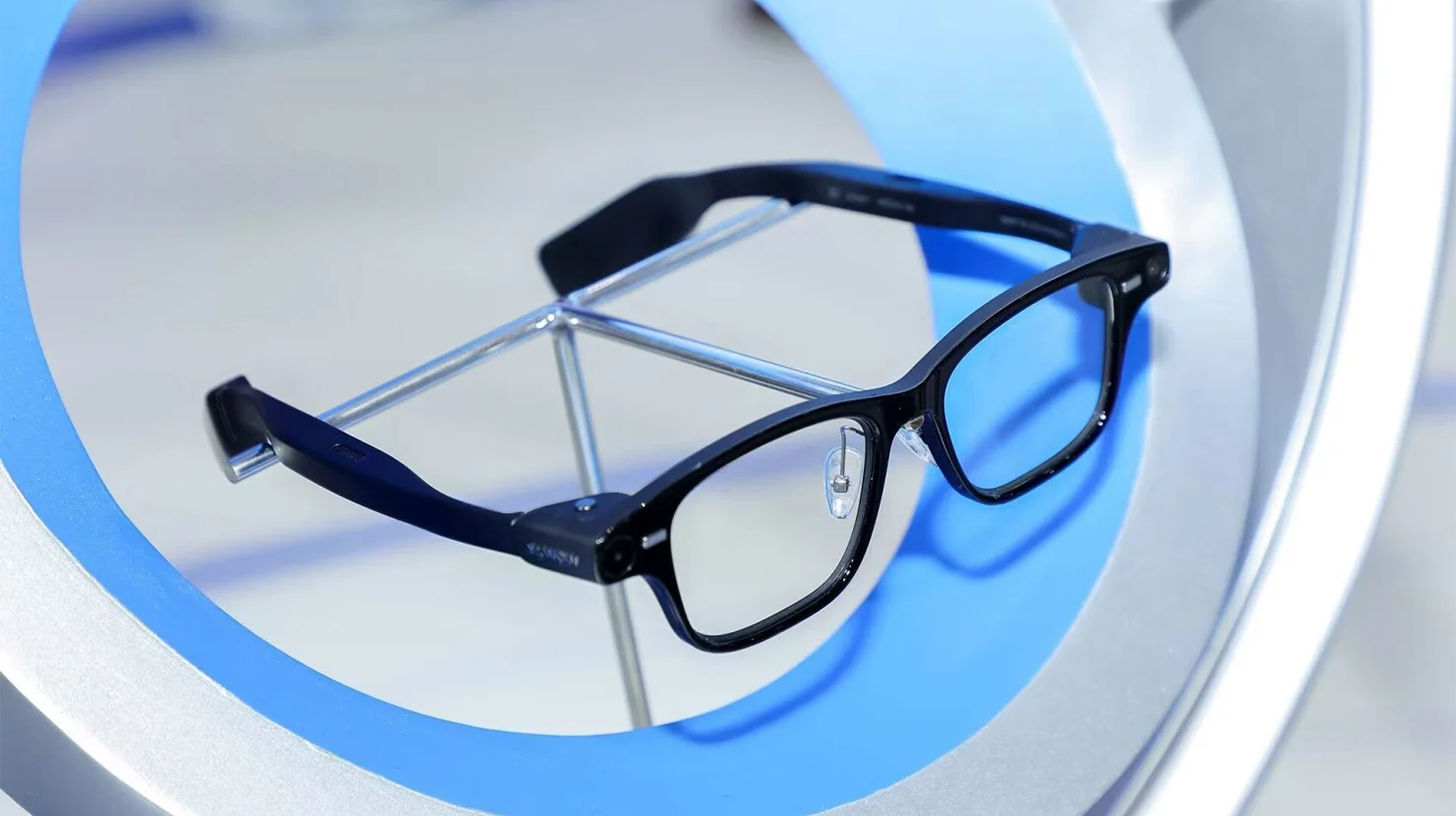
Smart Glasses: With its “Quark AI Glasses,” Alibaba is pushing the door wide open to intelligent glasses – Image: Alibaba
Display, Super-Ki and 14 hours of battery: This is in Alibaba's new all-rounder
Say goodbye to smartphones? These glasses translate, pay, and navigate – all hands-free
From the end of 2025, Alibaba wants to set a new standard for smart everyday glasses with the "Quark Ai Glasses" and thus attack Meta, Google & Co. frontally. In addition to a full-fledged display, strong on-device AI and seamless integration into the Alibaba ecosystem, the group promises an ecosystem experience that goes far beyond the offer of many competitors.
A spirit of optimism in the Middle Kingdom
China's technology industry has been in a phase of self -acceleration for years. The government is driving the structure of strategic future segments, including semiconductor, artificial intelligence (AI) and XR technologies (extended reality). Alibaba is no longer a pure e-commerce specialist. The group is investing billions in cloud infrastructure, Large-Language models (LLMS) and mixed reality hardware. The curd Ai Glasses, which were presented as a "functioning prototype" for the first time at the World Artificial Intelligence Conference 2025 at the World Artificial Intelligence Conference 2025.
Suitable for:
- The spearhead of the innovation: China's top manufacturer and developer (top ten) by smart glasses and augmented reality glasses
From the pilot to the product: What is behind the curd ai glasses?
Design philosophy and form factor
Unlike the Ray Ban | Meta smart glasses, which hardly differ from sunglasses on the outside, alibaba pursues a hybrid strategy: the glasses should look light and fashionable, but thanks to heads-up display, offer real augmented reality added value. The engineers combine a monochrome micro-oled projector in the right version with a transparent, prism-based waveguide. This allows information or notifications directly into the field of vision without covering the environment.
Dual chip architecture: Snapdragon AR1+ and Alibaba co-processor
The heart of the hardware is Qualcomms Snapdragon AR1+ Gen 1, a processor specially developed for smart glasses that allows local AI calculations (small language models) without cloud connection. Alibaba complements this chip with an in-house neural processing co-processor, which performs parts of the large model QWEN 2.5-MAX in a compact form on the device. This combination enables functions such as image and text recognition in real time, even if no data connection is available.
Smart Glasses core components at a glance
The core components of the Smart Glasses show an overview that the Quark Ai Glasses have a Snapdragon AR1+ Gen 1 processor with Alibaba NPU, while the Ray-Ban use a Snapdragon AR1 Gen 1 and offer the meta smartglasses 26 % more efficiency and enable locally executable models. For the display, Quark relies on a micro-oled with 720p and a top value of 2000 nits, Ray-Ban does not use a display and meta offers a field of vision overlay for navigation and messages. The cameras also differ: Quark uses a dual camera with 12 MP and 6 MP video plus ice cream, Ray-Ban has a 12 MP camera and meta enables 3D depth recording and gesture control. The audio area consists of open loudspeaker drivers with a 5-microphone array, Ray-Ban also relies on a 5-microphone array with speakers, while meta rely on directional sound without earplugs. In the case of battery performance, Quark has a 600 mAh battery for 14 hours of use, Ray-Ban a 450 mAh battery for 8 hours and meta offers fast charging via a magnetic dock. The weight of the glasses is 49 grams without glasses, Ray-Ban at 48 grams for the base version, and Meta convinces with a slight design despite waveguide technology. Finally, the ecosystem shows itself: Quark integrates Alipay, Taobao, Amap and Dingtalk, Ray-Ban uses Meta, Instagram and WhatsApp, and meta offers deep integration into local services.
Functions that have everyday life and work merged
Communicate freehand
The glasses display incoming calls in a minimalist status bar. A double tap on the earpiece accepts the call, while bone conduction microphones allow the user to transmit their voice clearly – even in noisy environments.
Real-time translation and transcription
With the help of the slim version of QWEN, the system recognizes up to 30 languages and indicates translated subtitles directly in the lens. For conference participants, transcripts can be created at the same time and share with Dingtalk Meeting.
"Look-and-Pay" with Alipay
Perhaps the most striking distinguishing feature is the deep Alipay integration. Users simply scan the retailer's QR code at the supermarket checkout. The glasses recognize it, visually confirm the amount, and initiate the payment process with a short voice command. This eliminates the need to pull out their smartphone – a process that millions of Chinese consumers perform several times a day.
Price comparisons and shopping assistance
When a product is viewed in the store, the glasses photograph the barcode or recognize the object using AI. Within seconds, a list of Taobao prices, display sizes, and reviews appears. A swipe to the left adds the item to the digital shopping cart—a seamless online-to-offline loop that Meta hasn't yet offered.
Navigation by AMAP
If you are walking in Shanghai, you will receive a subtle blue directional arrow in the field of vision at the next intersection. Laying instructions are announced via the surrounding tone without pulling the smartphone out of your pocket.
Market environment and competition
According to Markets & Markets, the global market for AR glasses will only just exceed $1 billion by 2025, but is expected to grow to nearly $10 billion by 2030. Analysts point to an average annual growth rate of around 59% – albeit from a low base.
China as a center
Start-ups such as XReal and Rokid have already sold a hundred thousands of devices to developers and early adopters, but mostly as pure entertainment accessories. Alibaba now enters the stage with a mass-compatible mainstream product that addresses everyday cases such as paying, translating or addressing navigation and attracting wider target groups.
Suitable for:
- Xpert study on “The Market for Smart Glasses” - Analysis of market penetration, competition and future trends
Meta, Snap, Google: Three paths in the west
- Meta relies on lifestyle and social media features, but without a (still) display, AR added value is missing.
- With Spectacles 4, SNAP provides an experiment device for creative, but so far without a fixed business plan.
- Google works on Project Iris, but focuses on enterprise environments.
Alibaba chooses the combination of consumer price breakers and ecosystem binding, similar to Apple at the iPhone start 2007.
Technological background
Qwen 2.5-Max: A quick look into the "engine compartment"
The open source model QWen is the strongest Chinese LLM in its class in benchmarks and is over GPT-4 base for Chinese-language tasks. The version adapted for the glasses partly runs in EDGE mode on the AR1+chip:
- Segmentation of the voice model in "Prompt-Head" (on-device) and "Reasoning-Core" (cloud).
- On-Device part recognizes trigger sentences ("How high is the price ...?") And only directs relevant data into the cloud, saves bandwidth.
- The answer returns to less than 200 ms and is issued in natural sentences in German or English.
Power management and cooling
Micro vapor chambers in the ironing derive heat. With 14 h mixed use (music, two hours of display, 30 minutes of video recording) there are still 20% reserve. The glasses load from 0% to 80% within 40 minutes by magnetic pogo pin.
Data protection and ethics
Chinese wearables are often under general suspicion of playing back to servers in Germany in the west. However, Alibaba asserts that camera images remain encrypted locally by default and are only transferred to Alibaba Cloud when the cloud-offload is active. In addition, the company works on a "Privacy Guardian" chip that isolates biometric data, similar to Apple's Secure Enclave.
Economic importance for alibaba
The group generates around 35% of its sales with cloud and logistics services in 2024; the core business e-commerce stagnates. A vertical hardware offensive opens up new sources of income: glasses hardware, pro licenses for qwen and higher user loyalty in stores. In the long term, recurring subscriptions for navigation, translation packages and cloud memory are waving.
Challenges on the way to the mass product
- Price: Rumors of over $ 399 basic model could be acceptable in China, but have skepticism abroad.
- Comfort: Although 49 g light, glasses with displays often feel front -heavy.
- Ecosystem boundaries: Alipay is hardly widespread outside of China; Without an alternative payment provider, a killer feature is missing.
- Regulatory: USA and EU are increasingly examining how sensitive image and audio data are processed.
Alibaba Quark Ai Glasses: The breakthrough for AR glasses in Asia and India?
If Alibaba manages to launch the glasses simultaneously in Southeast Asia and India, where Alipay+ already has partnerships, it could tap into a hundred million potential users there. If a developer kit for mini-apps (“mini-Taobao”) is released at the same time, third-party services – for example, for fitness, education, or tourism – could emerge.
In the long term, the interface man-computer shifts into the field of vision from the smartphone display. Medicines are already testing operating training with AR-overlays; Logistics company aperture picking information. Alibaba could gain a foothold here with Quark Ai Glasses and win new industrial buyers.
With the Quark AI Glasses, Alibaba is pursuing an integrated strategy combining a compelling hardware foundation, powerful edge AI, and a dense service network. If the ambitious battery life and display quality can be achieved in the production device, the glasses could find their way into millions of Chinese households by early 2026. However, for a global breakthrough, data protection concerns must be addressed, partnerships beyond Alipay established, and an international app marketplace established. If this succeeds, the Quark glasses could put Meta, Snap, and Google under pressure—and finally transform the everyday "glasses" into a personal AI portal.
Suitable for:
Your global marketing and business development partner
☑️ Our business language is English or German
☑️ NEW: Correspondence in your national language!
I would be happy to serve you and my team as a personal advisor.
You can contact me by filling out the contact form or simply call me on +49 89 89 674 804 (Munich) . My email address is: wolfenstein ∂ xpert.digital
I'm looking forward to our joint project.

